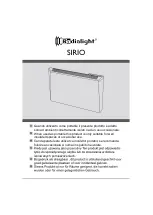
Manuale di installazione, Uso e Manutenzione -
Installation, Use and Maintenance Manual
pag. 3
6
11- LOCALIZZAZIONE DEI GUASTI
11 - IDENTIFyING bREAKDoWNs
A fine utilizzo i recuperatori andranno smaltiti in osservanza delle
normative vigenti, al di fuori del normale flusso dei rifiuti solidi
urbani. Gli apparecchi dismessi devono essere raccolti separata-
mente per ottimizzare il tasso di recupero e riciclaggio dei mate-
riali che li compongono ed impedire potenziali danni per la salute
e l’ambiente.
I materiali che compongono i recuperatori sono :
• Lamiera Preverniciata
• Lamiera zincata
• Alluminio
• Rame
• Poliuretano
• Polietilene
• Plastica
• Acciaio inox
• Vetro al quarzo
At the end of their life span the heat recovery units must be dis-
posed of in compliance with the Standards in force, prescribing
the disposal out of the normal flow of solid urban waste. The
appliances that are no longer used must be collected separately
in order to optimise the rate of recovery and recycling of the
materials of which they are made and to prevent potential dama-
ge to the health and environment.
The materials making up the heat recovery units are:
• Painted sheet steel
• Galvanised sheet steel
• Aluminium
• Copper
• Polyurethane
• Polyethylene
• Plastic
• Stainless steel
• Quartz glass
SINTOMI
POSSIBILI CAUSE
symPToms
PossIblE CAusEs
I ventilatori
non funzionano
- L'alimentazione non è inserita.
- Gli interruttori del termostato non sono nell'esatta
posizione di funzionamento.
- Ci sono dei corpi estranei che bloccano le giranti.
- Collegamenti elettrici allentati.
- Verificare presenza segnale di regolazione 0-10 V
(motore EC)
The fans
do not work
- The power supply is not inserted.
- The thermostat switches are not in the exact func-
tioning position.
- There are foreign bodies that block the rotors.
- Loosened electric connections.
- Check presence of 0-10 V control signal
(EC motor)
Motore fuori
assorbimento
- Pressione inferiore a quella richiesta e quindi portata
eccessiva:si può intervenire aumentando le perdite
di carico con serrande e regolatori.
- Eccessiva densità del fluido.
- Velocità di rotazione troppo alta.
motor out
of absorption
- Static pressure at that requested and therefore
excessive flow rate: it is possible to intervene by
increasing the load using dampers and adjusters.
- Rotation speed too fast.
Portata aria eccessiva
- Perdite di carico del sistema sovrastimate.
Excessive air flow rate
- System pressure drops over-estimated.
Portata aria scarsa
- Perdite di carico del sistema sottostimate.
- Ostruzioni nelle canalizzazioni.
- Velocità di rotazione troppo bassa: verificare sulla mor-
settiera del motore che il collegamento sia corretto ed
inoltre che la tensione corrisponda a quella di targa.
- La girante gira rovescia.
low air flow rate
- System pressure drops under-estimated.
- Obstructions in the ducts.
- Rotation speed too slow: check that the connection
is correct on the motor terminal board and also that
the voltage corresponds to that on the plate.
- The rotor turns in reverse.
Rumorosità
- Portata eccessiva.
- Usura o cricche nei cuscinetti.
- Ventilatore squilibrato.
- Presenza di materiale estraneo nella coclea.
Noise
- Excessive flow rate.
- Wear or cracks in the bearings.
- Unbalanced fan.
- Presence of foreign material in the auger.
Forti vibrazioni
- Girante squilibrata a causa di usura o di depositi di
polvere.
- Strisciamento della girante sulla coclea dovuto a
deformazioni.
- Ostruzioni nelle canalizzazioni.
strong vibrations
- Rotor unbalanced due to wear or deposits of dust.
- The rotor rubs against the auger due to deforma-
tions.
- Obstructions in the ducts.
12- SMALTIMENTO
12 - DIsPosAl
DC MAN I 05 000 CFP 03 - Copia_SIC 07/02/2018 11.38 Pagina 39
10.
3
Controlli annuali
• Verifica di tutta l'apparecchiatura elettrica ed in particolare il serraggio
delle connessioni elettriche
• Verifica del serraggio di tutti i bulloni, dadi, flangie e connessioni idriche
che le vibrazioni avrebbero potuto allentare.
10.
3
yearly checks
• Check all electric appliances and particularly the tightness of the elec-
tric connections
• Check the tightness of all bolts, nuts, flanges and water connections
that vibrations may have loosened.





































